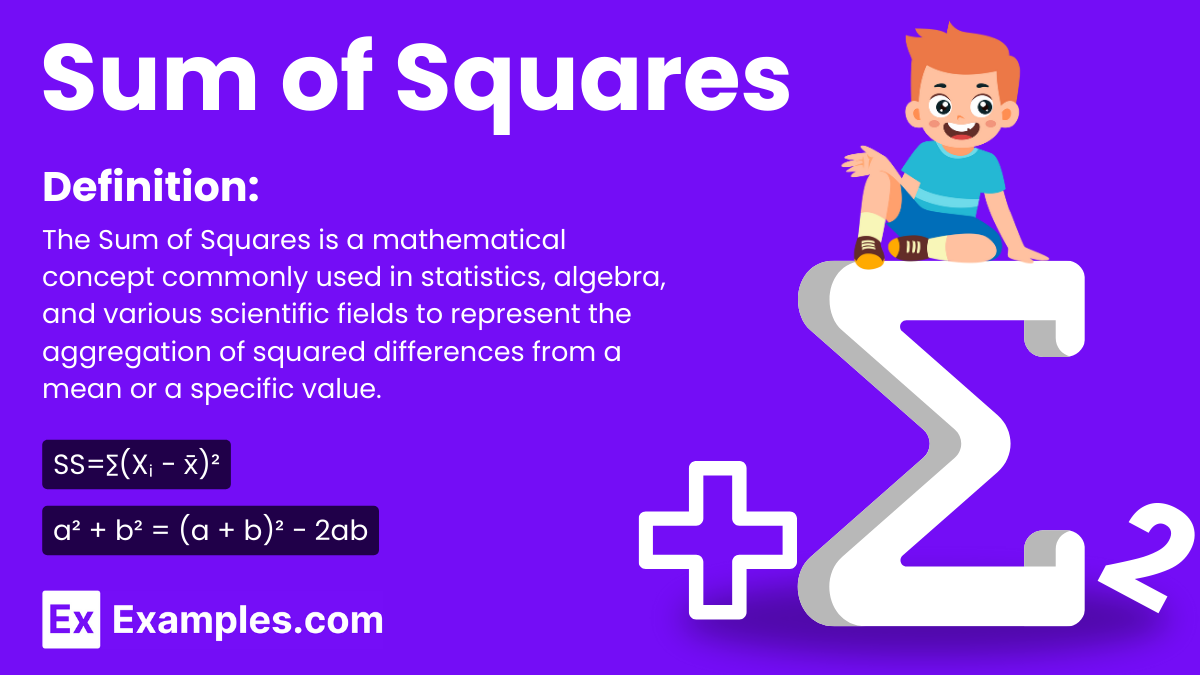What is the sum of squares of 3 and 4?
12
25
16
7

The Sum of Squares is a mathematical concept commonly used in statistics, algebra, and various scientific fields to represent the aggregation of squared differences from a mean or a specific value.

| Field | Sum of Squares Formula |
|---|---|
| Statistics | SS=∑(Xᵢ− X ˉ ) ² |
| Algebra | a² + b² = (a + b)² − 2ab |
| For “n” Terms | Sum of Squares Formula for “n” numbers = 1² + 2²+ 3²……. n² = [n(n + 1)(2n + 1)] / 6 |
The Sum of Squares is a mathematical and statistical concept used to describe the dispersion or variability of a set of data points. It is a key component in the calculation of variance, which in turn is used to calculate standard deviation, a measure of the spread of a dataset. The sum of squares formula differs slightly depending on its application context, such as statistics, regression analysis, or algebra.
In statistics, the sum of squares is used to measure the total variance in a dataset from its mean. The formula is as follows:
SS=∑(Xᵢ− X ˉ ) ²
Where:
In the context of regression analysis, the sum of squares is divided into two parts: the regression sum of squares (SSR) and the residual sum of squares (SSE). SSR measures how much of the data’s total variation is explained by the model. The formula for SSR is:
SSR=∑nᵢ₌₁₀==(y−yˉ)2
Where:
The residual sum of squares (SSE) measures the amount of variation in the dataset that the model does not explain. The formula is:
SSE=∑ni=(yi−y^i)2
Where:
The total sum of squares (SST) is the overall variance in the observed data and is the sum of SSR and SSE:
SST=SSR+SSE
Or it can be calculated directly as:
SST=∑i=(yi−yˉ)2
Where yi is the observed value and yˉ is the mean of the observed values.
In algebra, the sum of squares often refers to the sum of the squared values of terms. For example, for two terms a and b, the sum of squares is a2+b2.
If you have a dataset: 3, 5, 7
Thus, the sum of squares for this dataset is 8.
The Sum of Squares is a critical concept in statistics that represents a measure of variability or dispersion within a dataset. It is used to calculate the variance, helping to understand how each data point differs from the mean of the dataset. The Sum of Squares is foundational in various statistical analyses, including the analysis of variance (ANOVA), regression analysis, and calculating standard deviation.
To calculate the Sum of Squares Error, follow these steps:
he formula for the sum of squares of the first n natural numbers is a fundamental concept in mathematics, providing a quick way to calculate the sum of each number from 1 to n squared.
The sum of squares of the first n natural numbers is given by:
Sum of squares=[n(n+1)(2n+1)]/6
To illustrate how the formula works, let’s calculate the sum of squares of the first 3 natural numbers:
Sum of squares=3(3+1)(2⋅3+1)6=3⋅4⋅76=846=14Sum of squares=63(3+1)(2⋅3+1)=63⋅4⋅7=684=14
So, the sum of the squares of the first 3 natural numbers is 14.
If n=3, what is the sum of squares of the first n natural numbers?
Using the formula : [n(n+1)(2n+1)]/6
[3(3+1)(2⋅3+1)]/6=(3⋅4⋅7)/6=84/6=14
The sum of squares is 14.
Calculate the sum of squares of the first 5 natural numbers.
Applying the formula [n(n+1)(2n+1)]/6, for n=5:
[5(5+1)(2⋅5+1)]/6=(5⋅6⋅11)/6=330/6=55
The sum of squares is 55.
Determine the sum of squares of numbers from 1 to 4.
Using the sum of squares formula, for n=4:
[4(4+1)(2⋅4+1)]/6=(4⋅5⋅9)/6=180/6=30
The sum of squares is 30.
What is the sum of the squares of the first 10 natural numbers?
For n=10 in the sum of squares formula:
[10(10+1)(2⋅10+1)]6=(10⋅11⋅21)6=2310/6=385
The sum of squares is 385.
If a sequence has 6 terms, what is the sum of the squares of these terms?
Substitute n=6 into the formula:
[6(6+1)(2⋅6+1)]/6=7⋅13=91
The sum of squares for 6 terms is 91.
The sum of the square of a number refers to squaring the number (multiplying it by itself) and then summing the result, often used in sequences.
The sum of squares measures data variability, indicating the dispersion of data points around the mean in a dataset.
In statistics, SS stands for Sum of Squares, a key calculation that quantifies the variation within a set of values.
To sum two squares, calculate the square of each individual number (multiply each by itself) and then add the results together.
The formula for the sum of squares of n numbers is [n(n+1)(2n+1)]/6 applicable for the first n natural numbers.
The sum of two squares is not always a square; it depends on the specific numbers. For example, 1² + 2² = 5, which is not a perfect square.
Text prompt
Add Tone
10 Examples of Public speaking
20 Examples of Gas lighting
What is the sum of squares of 3 and 4?
12
25
16
7
What is the sum of squares of 5 and 7?
50
74
82
90
Find the sum of squares of 2, 3, and 6.
40
49
53
61
What is the sum of squares of 8 and 9?
144
145
150
163
If a = 4 and b = 5, what is a² + b²?
41
39
42
46
Determine the sum of squares of 1, 2, and 7.
49
54
55
58
What is the sum of the squares of 6 and 10?
100
136
160
196
If x = 3 and y = 4, what is x² + y²?
25
30
35
40
Calculate the sum of squares for 7, 8, and 10.
149
154
165
174
Find the sum of the squares of 2, 5, and 9.
90
100
110
120
Before you leave, take our quick quiz to enhance your learning!

